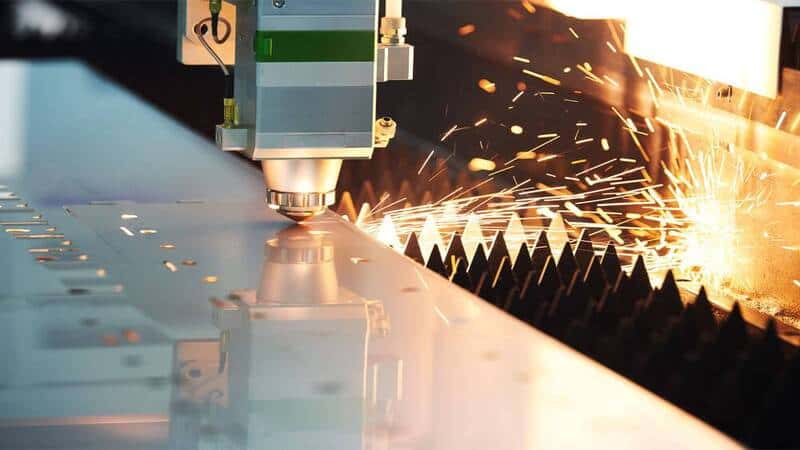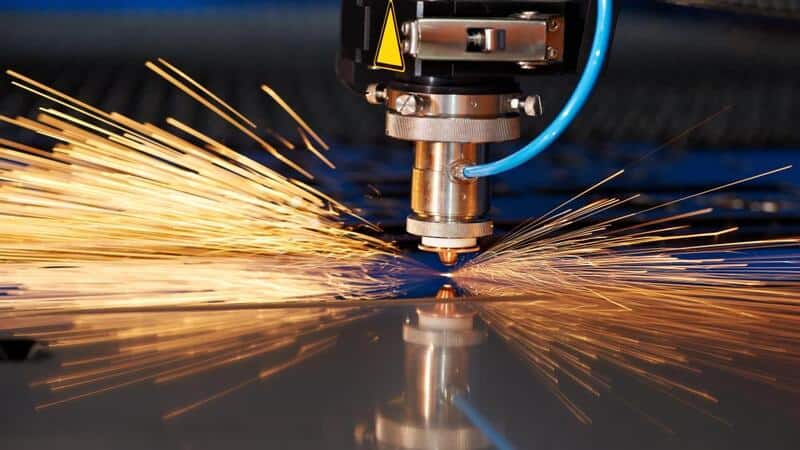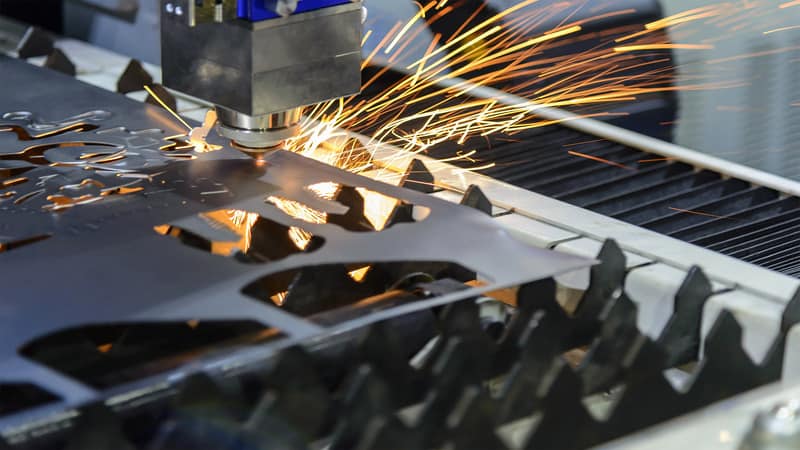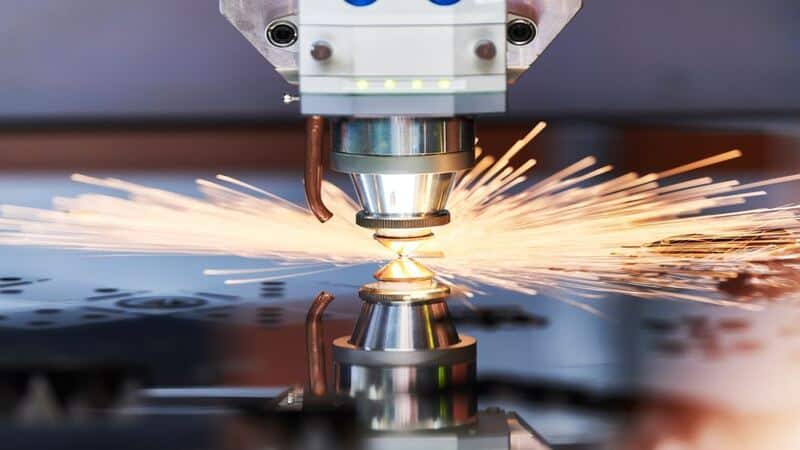The laser cutting process is a modern and rapidly growing design method. It is being used mainly in industrial and artistic manufacturing.
This is a thermal process that uses a concentrated laser beam. The laser beam is focused on a particular area of the metal you want to cut or design. The metal is melted due to the laser power, which evaporates by an assist gas jet. Finally, a kerf is formed, and your design has been established.
Like every other process, laser cutting also requires maximum efficiency to achieve maximum results. Consequently, making this technology efficient requires a lot of science and research.
Read ahead to understand the science behind laser cutting speed and feed to achieve efficient laser cutting processes.
Understand Laser Cutting Speed and Feed

The laser cutting speed and feed are important cutting parameters for any laser cutting process.
Laser Cutting Speed
The speed explains the motion of the cutting head of the laser cutting machines. It describes how fast the cutting head moves over the surface you want to engrave or cut.
The faster the speed of the cutting head, the lesser the laser beam is exposed to the material. Similarly, the slower its speed, the more the material is exposed to the laser beam.
High laser cutting speed is used for engraving large-scale products. Their maximum cutting speeds vary from 80 to 100 percent.
On the other hand, lower cutting speeds are used to make engravings on wooden products. Here, the maximum cutting speed should not go above 10 percent.
This parameter is measured in meters per minute or feet per minute. It depends on the size and surface area of the product being cut or engraved.
Cutting speed is useful for optimizing different factors. These include the life of the tools and machine parts as well as the total power consumption.
Laser Cutting Feed
The cutting feed allows you to note the rate of the laser cutting appliance. It denotes the distance and speed at which the cutting head moves throughout the laser cutting process.
The cutting feed rate is measured in the units of distance per revolution covered. This could either be in inches per revolution or millimeters per revolution. It also depends on the size and surface area of your cut or engraved product.
The feed rate is important to note the machining time. It also tells you about the roughness of the final product.
Link Between Laser Cutting Speed and Feed
The laser cutting speed provides the exact speed at which the laser is cutting or engraving the metal surface. In contrast, the feed provides the exact distance the laser-cutting head covers in one revolution.
Hence, a link is established between the laser cutting speed and feed. The feed turns out to be the velocity at which the laser cutter works.
Do Cutting Speed and Feed Affect the Efficiency of the Laser Manufacturing Process?

Cutting speed and feed are two important laser-cutting parameters. These manufacturing process parameters are used to check the entire procedure closely.
They make sure that all the different machine tools and parts are working at their optimum potential. If either the speed or feed values are off their normal limits, there must be some error. This allows you to check for any malformations or damages. This way, any error during the manufacturing process can be rectified.
Additionally, these two laser-cutting parameters give details about the finished product. These process parameters determine the rate of metal being scraped off during the process. Furthermore, they also provide information regarding the total power required to complete the manufacturing process.
The speed and feed rate vary depending on the type of material under process. These process parameters are pre-determined and noted for various metals and surfaces. Hence, you can determine if your manufacturing procedure is efficient by comparing the standard values.
Hence, this is how speed and feed affect the efficiency of the laser-cutting process.
Factors Influencing Speed and Feed in Laser Cutting Process
Different process parameters affect speed and feed in laser cutting. The quality assessment of the laser cutting processes determines the factors.
Here are the various factors that influence speed and feed in laser cutting.
Properties of Process Materials
The laser cutting process is a very flexible one. It does not depend on the shape of the metal you want to cut or engrave. However, it does depend on the physical properties of the metal. Hence, speed and feed are affected by the properties of the material.
Properties such as surface roughness matter a lot. Metals that have a large surface roughness experience poor laser cutting. On the other hand, metals that have smooth surface quality characteristics experience a well-defined laser cut.
The greater the surface roughness of the material, the harder it is to achieve a perfect cut.
Sheet Thickness
Cutting speed and feed are influenced by the thickness of the metal.
The fiber laser cutting machines generally have an output power of 500 to 1000 Watts. Those with power greater than 2000 Watts are considered to be high-powered fiber laser cutting machines.
Metals of different thicknesses are cut best by laser machines of suitable power inputs. Carbon steel of 14mm maximum thickness is best cut by a fiber laser cutting machine of less than 1000W power. Similarly, powered machines are also used to cut stainless steel metals. However, the stainless steel metals must be less than 6mm in thickness.
The respective metal thickness must meet the power requirements of the fiber lasers machines. This ensures that the cutting speed is fast. The laser cut quality of the fiber laser cutting systems is also maintained properly. All these factors can also help you save cost on the laser beam’s laser energy.
The process efficiency will deteriorate if the mild and stainless steels or carbon steel metals are thicker. The cutting speed and feed would be slow. You would experience poor energy efficiency as well. It is even possible that the thicker carbon or stainless steel products do not cut through.
The laser-cutting process is better if the metal sheet thickness is less than the standard value. For example, less than 1mm of stainless steel will undergo a great laser cutting process. The stainless steel product’s edge and overall cutting quality would be immaculate.

Gas Flow Rate
The rate of gas flow is one of the important laser-cutting parameters.
Laser-cutting machines use auxiliary gas for cutting purposes. The gas flow and gas pressure are important factors to be considered. Hence, it is vital to understand the gas dynamics and choose the right auxiliary gas in the laser cutting process.
The auxiliary or assist gas is ejected with the laser beam. A coaxial angle is used for the ejection of the assist gas. This allows the lens to be protected from any pollution. The assist gas pressure also discards any molten material slag accumulating at the bottom during laser cutting.
Higher assist gas pressure is required to cut thin surfaces like stainless steel metals at high pressure. The high gas pressure prevents any molten metal or molten material from getting stuck at the bottom.
The gas pressure must be reduced appropriately if the metal surface is thick. This will optimize your laser cutting speed and feed.
Proper Nozzle Type for Laser Beam
The nozzle will also affect the laser cutting speed and feed. The nozzle diameter, aperture, integrity, height, and kind all contribute to the laser cutting parameters. The nozzle diameter also affects the beam diameter. So choosing the right nozzle is important.
Thin surfaces should use a small nozzle diameter for the cutting process. At the same time, thicker surfaces should be cut or engraved using a larger nozzle diameter. This would provide high efficiency to your laser cutting process. The right nozzle diameter will optimize the laser cutting speeds and feed and increase the process efficiency.
Strategies to Optimize Laser Cutting Speed and Feed

You might encounter various problems during the laser cutting procedure. Issues such as burr formation, malformation, failure in the cutting process, cutting tool breakdown, discoloration, etc., may occur.
Be it laser fusion cutting, industrial cutting, or using conventional cutting methods; these problems may arise anywhere. This would disrupt the cutting speed and feed, producing poor laser cut and surface quality.
Here are some strategies you can adopt to optimize laser cutting speed and feed.
Prevent Glitches
Try your best to ensure no glitches in your software system. Make sure the components of the software are working in an apt condition. Regularly clean the machine parts to prevent any dust or slag accumulation.
This would help prevent any laser-cutting optimization problems.
Avoid Malformations
The different thermal properties of the metal cause it to heat up due to the beam power. The heat-affected zone of the metal also causes it to change the metal’s structure.
Any dents or disrupted cutting quality would affect the speed and feed of the laser cutting process. Hence, such errors must be avoided at all costs.
Advantages of Maximizing Laser Cutting Efficiency
There are many advantages to maximizing laser cutting efficiency.

Enhanced Cutting Quality Characteristics
Maximizing the laser cutting process would increase the cutting quality characteristics. The final product’s cut, surface, and cutting-edge quality would be enhanced.
Quality assessment of the product shows high precision. The cutting performance of the fiber lasers also enhances maximum laser cutting efficiency. Such precise and clean quality characteristics cannot be accomplished using another method.
Decreased Costs
The laser cutting speed and feed get optimized at maximum efficiency. Energy consumption is greatly reduced as well.
Hence, the decreased energy consumption allows the cutting process to become cost-effective.
Increased Safety
Cutting metals using a laser beam and laser power might seem dangerous. However, it is one of the safest procedures.
The faster the speed is, the safer the process will be carried out. Hence, maximizing the laser cutting efficiency would increase safety and enhance process optimization.
Greater Customer Satisfaction
You can expect greater customer satisfaction by getting the laser cutting process to its maximum efficiency.
The cutting performance and overall process efficiency get improved a lot. The final products have smoother cut-edge quality due to high-efficiency beam power, speed, and feed. The material removal rate and cutting kerf width would meet the customers’ requirements.
Bulk orders would also have accurate average kerf width, meeting the customers’ demands.
Therefore, maximizing the laser cutting efficiency would allow you to produce well-finished products. These would satisfy your customers and increase your sales and profit.
Final Thoughts
It is very important to make your laser-cutting process highly efficient. You must understand the science involved behind the process parameters.
Having adequate knowledge regarding different aspects of the laser cutting process is necessary, especially in industrial cutting. These include beam absorption characteristics, laser intensity, incident laser power, the surface roughness of the metal, contour cutting, selective laser, etc. You should also be aware of the product’s material removal rate and cutting path in action.
The laser cutting feed and speed would be improved as well. All this would ensure a highly efficient laser-cutting process.
Discover the Perfect Solution for Your Business with Baison
Baison only delivers perfection to its clients.
Be its fiber laser cutting machines, welding machines, cleaning machines, or CO2 laser cutting machines, Baison has everything under one roof. You can get any machine you want at the best rate and quality from us.
To request a quotation for your desired order, contact us now.





